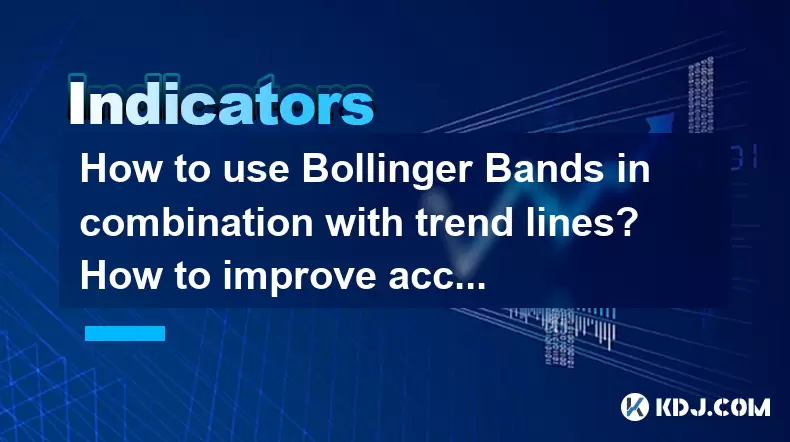-
 bitcoin
bitcoin $112195.049338 USD
2.42% -
 ethereum
ethereum $4124.915858 USD
2.81% -
 tether
tether $1.000570 USD
0.02% -
 xrp
xrp $2.861568 USD
2.25% -
 bnb
bnb $1000.346670 USD
3.04% -
 solana
solana $209.070819 USD
3.38% -
 usd-coin
usd-coin $0.999870 USD
0.02% -
 dogecoin
dogecoin $0.235379 USD
2.65% -
 tron
tron $0.335681 USD
-0.20% -
 cardano
cardano $0.803501 USD
3.38% -
 hyperliquid
hyperliquid $47.120881 USD
3.56% -
 chainlink
chainlink $21.501300 USD
3.44% -
 ethena-usde
ethena-usde $1.000571 USD
0.02% -
 avalanche
avalanche $29.793378 USD
3.62% -
 stellar
stellar $0.366964 USD
2.42%
How to use Bollinger Bands in combination with trend lines? How to improve accuracy?
Bollinger Bands and trend lines enhance crypto trading by measuring volatility and visualizing market direction, offering nuanced insights when combined.
May 21, 2025 at 10:50 pm

Bollinger Bands and trend lines are two powerful tools in the arsenal of any cryptocurrency trader looking to enhance their technical analysis. Bollinger Bands are used to measure market volatility and identify overbought or oversold conditions, while trend lines help traders visualize the direction of the market. Combining these tools can offer a more nuanced approach to trading, providing insights that might be missed when using them in isolation. In this article, we will explore how to effectively use Bollinger Bands in combination with trend lines and discuss strategies to improve the accuracy of your trading decisions.
Understanding Bollinger Bands
Bollinger Bands consist of three lines: a middle band, an upper band, and a lower band. The middle band is typically a simple moving average (SMA) of the closing prices over a specific period, often set to 20 days. The upper and lower bands are calculated by adding and subtracting two standard deviations from the middle band, respectively.
When the price of a cryptocurrency touches or crosses the upper band, it may be considered overbought, suggesting a potential sell signal. Conversely, when the price touches or crosses the lower band, it may be considered oversold, indicating a potential buy signal. However, these signals should be used in conjunction with other indicators to avoid false positives.
Understanding Trend Lines
Trend lines are straight lines drawn on a chart to connect a series of prices, helping to identify the direction of the market. An uptrend line is drawn along the lows of the price action, indicating that the price is generally increasing. A downtrend line is drawn along the highs of the price action, indicating that the price is generally decreasing.
Trend lines can be used to identify potential support and resistance levels. When the price approaches a trend line, it may either bounce off it, confirming the trend, or break through it, signaling a potential reversal.
Combining Bollinger Bands and Trend Lines
To combine Bollinger Bands and trend lines effectively, traders should look for instances where these two tools provide complementary signals. Here’s how you can do it:
- Identify the Trend: Start by drawing a trend line on your chart. If you’re looking at an uptrend, draw the line along the lows of the price action. For a downtrend, draw the line along the highs.
- Overlay Bollinger Bands: Once you have your trend line, overlay Bollinger Bands on the chart. Make sure the period and standard deviation settings are appropriate for your trading strategy.
- Look for Confluence: Pay attention to areas where the price touches both the trend line and one of the Bollinger Bands. For example, in an uptrend, if the price touches the lower Bollinger Band and the trend line simultaneously, it could be a strong buy signal. Conversely, in a downtrend, if the price touches the upper Bollinger Band and the trend line at the same time, it could be a strong sell signal.
Improving Accuracy with Bollinger Bands and Trend Lines
While combining Bollinger Bands and trend lines can provide valuable insights, it’s important to take steps to improve the accuracy of your trading signals. Here are some strategies to consider:
- Use Multiple Timeframes: Analyzing the same asset across different timeframes can help confirm trends and signals. For instance, if you see a buy signal on a daily chart, check the weekly chart to see if the trend is also bullish on a larger scale.
- Incorporate Other Indicators: Bollinger Bands and trend lines can be used in conjunction with other technical indicators, such as the Relative Strength Index (RSI) or Moving Average Convergence Divergence (MACD), to confirm signals. For example, if the RSI indicates an oversold condition when the price touches the lower Bollinger Band and the trend line, it strengthens the buy signal.
- Backtest Your Strategy: Before applying your strategy to live trading, backtest it using historical data. This can help you understand how your strategy would have performed in the past and identify any potential weaknesses.
- Set Stop-Losses and Take-Profits: Always use stop-loss orders to limit potential losses and take-profit orders to secure gains. These can help you manage risk and ensure that you stick to your trading plan.
Practical Application of Bollinger Bands and Trend Lines
Let’s walk through a practical example of how to use Bollinger Bands and trend lines in a trading scenario:
- Step 1: Open your trading platform and select the cryptocurrency pair you want to analyze.
- Step 2: Draw a trend line on the chart. For this example, let’s assume we’re looking at an uptrend. Connect at least two lows with the trend line.
- Step 3: Overlay Bollinger Bands on the chart. Use the default settings of a 20-day SMA and two standard deviations.
- Step 4: Monitor the price action. When the price touches the lower Bollinger Band and the trend line simultaneously, consider this a potential buy signal.
- Step 5: Before entering a trade, confirm the signal with other indicators, such as the RSI. If the RSI is also indicating an oversold condition, the buy signal is strengthened.
- Step 6: Enter the trade and set a stop-loss just below the trend line to manage risk. Set a take-profit level based on your analysis of potential resistance levels.
Fine-Tuning Your Strategy
To fine-tune your strategy using Bollinger Bands and trend lines, consider the following adjustments:
- Adjust Bollinger Band Settings: Depending on the volatility of the cryptocurrency you’re trading, you may need to adjust the period and standard deviation settings of the Bollinger Bands. For highly volatile assets, you might want to use a shorter period and a larger standard deviation to capture more frequent signals.
- Refine Trend Line Placement: Pay close attention to the placement of your trend lines. Ensure that they are drawn accurately and that they connect significant price points. Sometimes, drawing multiple trend lines and observing which one the price respects more can be beneficial.
- Monitor Market Conditions: Keep an eye on overall market conditions and news events that could impact the price of the cryptocurrency you’re trading. For example, if there’s a major announcement expected, it might be wise to wait until after the event to make trading decisions.
FAQs
Q: Can Bollinger Bands and trend lines be used for all cryptocurrencies?A: Yes, Bollinger Bands and trend lines can be applied to any cryptocurrency. However, the effectiveness of these tools may vary depending on the volatility and trading volume of the specific cryptocurrency. Highly volatile assets might require more frequent adjustments to the settings of the Bollinger Bands.
Q: How often should I redraw my trend lines?A: Trend lines should be redrawn whenever the price action invalidates the current line. This could happen if the price breaks through the trend line and continues in the opposite direction, or if new price points emerge that are more significant than the ones used to draw the original line.
Q: What should I do if the price frequently touches the Bollinger Bands but doesn’t break them?A: If the price frequently touches the Bollinger Bands but doesn’t break them, it might indicate a period of consolidation or a strong trend. In such cases, you might want to wait for a clear breakout or use other indicators to confirm the strength of the trend before making a trading decision.
Q: Can Bollinger Bands and trend lines be used for short-term trading?A: Yes, Bollinger Bands and trend lines can be used for short-term trading. However, you may need to adjust the settings of the Bollinger Bands to shorter periods and use shorter timeframes for your charts to capture more frequent signals. Always ensure that you are using appropriate risk management techniques when trading on shorter timeframes.
Disclaimer:info@kdj.com
The information provided is not trading advice. kdj.com does not assume any responsibility for any investments made based on the information provided in this article. Cryptocurrencies are highly volatile and it is highly recommended that you invest with caution after thorough research!
If you believe that the content used on this website infringes your copyright, please contact us immediately (info@kdj.com) and we will delete it promptly.
- Crypto AI Tokens: Fetch.ai, Render, and the AI Revolution in 2025
- 2025-09-29 23:05:15
- OZ Token: Ozak AI's 200x Gains - Hype or Reality?
- 2025-09-29 22:45:12
- BlockchainFX: The Crypto Investment You Can't Afford to Miss?
- 2025-09-29 22:45:12
- XRP Recovery, Crypto Rally, and Under $1 Crypto: Navigating the Market
- 2025-09-29 23:25:12
- Solana, Bitfrac, and Crypto Investment: Navigating the High-Growth Landscape
- 2025-09-29 23:45:14
- ChatGPT's Hot Take: BlockchainFX Leads the Crypto Presale Pack
- 2025-09-29 22:50:01
Related knowledge

What is a tower bottom candlestick pattern? Does it have a high success rate?
Sep 22,2025 at 07:18am
Tower Bottom Candlestick Pattern Explained1. The tower bottom candlestick pattern is a reversal formation that typically appears at the end of a downt...

What is a black hole pattern in the MACD indicator? Is it a cause for concern?
Sep 21,2025 at 06:54pm
Bitcoin's Role in Decentralized Finance1. Bitcoin remains the cornerstone of decentralized finance, serving as a benchmark for value and security acro...

How can I use the psychological line (PSY) to determine market sentiment?
Sep 17,2025 at 02:19pm
Understanding the Psychological Line (PSY) in Cryptocurrency TradingThe Psychological Line, commonly referred to as PSY, is a momentum oscillator used...

How can I determine if a double top pattern has officially formed?
Sep 21,2025 at 03:18am
Understanding the Structure of a Double Top Pattern1. A double top pattern consists of two distinct peaks that reach approximately the same price leve...

What is the Golden Valley pattern on the moving average? Is it better than the Silver Valley pattern?
Sep 21,2025 at 02:54pm
Understanding the Golden Valley Pattern in Moving Averages1. The Golden Valley pattern is a technical formation observed in cryptocurrency price chart...

What does a death cross of the RSI in the strong zone (above 50) mean?
Sep 17,2025 at 10:54pm
Understanding the Death Cross in RSI Context1. The term 'death cross' is traditionally associated with moving averages, where a short-term average cro...

What is a tower bottom candlestick pattern? Does it have a high success rate?
Sep 22,2025 at 07:18am
Tower Bottom Candlestick Pattern Explained1. The tower bottom candlestick pattern is a reversal formation that typically appears at the end of a downt...

What is a black hole pattern in the MACD indicator? Is it a cause for concern?
Sep 21,2025 at 06:54pm
Bitcoin's Role in Decentralized Finance1. Bitcoin remains the cornerstone of decentralized finance, serving as a benchmark for value and security acro...

How can I use the psychological line (PSY) to determine market sentiment?
Sep 17,2025 at 02:19pm
Understanding the Psychological Line (PSY) in Cryptocurrency TradingThe Psychological Line, commonly referred to as PSY, is a momentum oscillator used...

How can I determine if a double top pattern has officially formed?
Sep 21,2025 at 03:18am
Understanding the Structure of a Double Top Pattern1. A double top pattern consists of two distinct peaks that reach approximately the same price leve...

What is the Golden Valley pattern on the moving average? Is it better than the Silver Valley pattern?
Sep 21,2025 at 02:54pm
Understanding the Golden Valley Pattern in Moving Averages1. The Golden Valley pattern is a technical formation observed in cryptocurrency price chart...

What does a death cross of the RSI in the strong zone (above 50) mean?
Sep 17,2025 at 10:54pm
Understanding the Death Cross in RSI Context1. The term 'death cross' is traditionally associated with moving averages, where a short-term average cro...
See all articles


























![[Pycoin] PI Coin -Shocking Listance of Pycoin?! 'Rebellion' This time ... Pay attention to #paikoin [Pycoin] PI Coin -Shocking Listance of Pycoin?! 'Rebellion' This time ... Pay attention to #paikoin](/uploads/2025/09/29/cryptocurrencies-news/videos/pycoin-pi-coin-shocking-listance-pycoin-rebellion-time-pay-attention-paikoin/68da82f23cec1_image_500_375.webp)















































